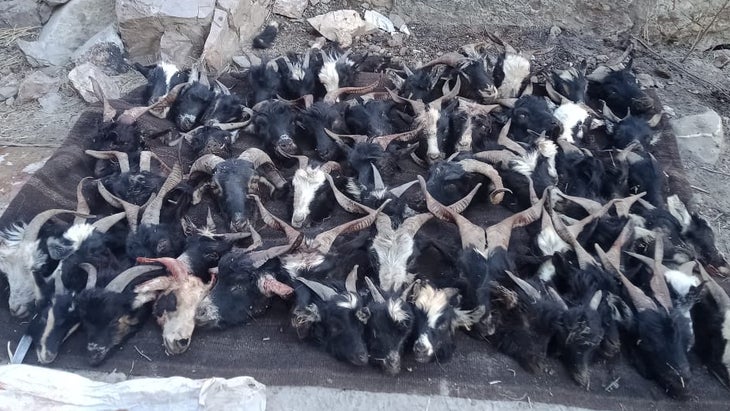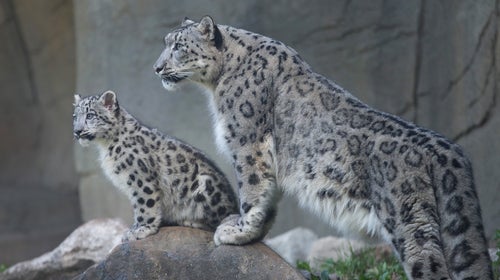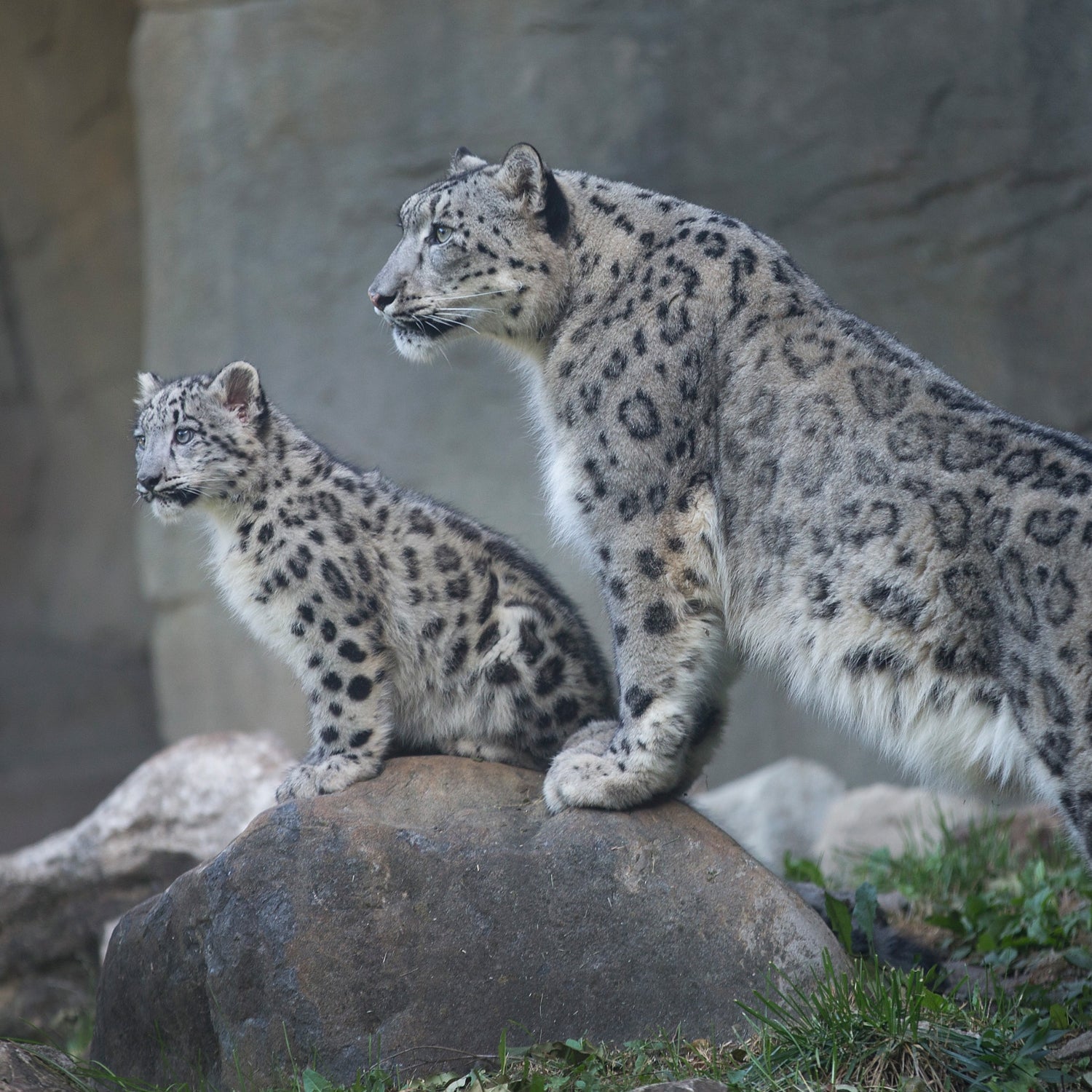Like most people in Koma, a village in the vast desert of Nepal’s remote Dolpa district, Dakpa Gurung has never had it easy. Since his youth in this tiny town of a few low stone homes and terraced wheat fields, he has scraped a living out of the dramatic landscape on foot, shepherding large flocks of pashmina goats through the mountains.
Dolpa is one of the poorest and most isolated regions in Nepal, itself one of the poorest countries in Asia. The vast majority of residents live extremely close to the bone, patching together a living by herding livestock and subsistence farming crops of buckwheat, potatoes, and barley. After trade across the nearby border with China shut down in 2020 in response to the COVID-19 pandemic, the demand for goats in Nepal triggered a sort of gold rush. Last fall, a healthy male goat would fetch up to 30,000 rupees ($245) from traders, up from 20,000 rupees ($160) the year before. In a country where the average per capita income hovers around $1,000 per year, Gurung’s family flock of nearly 70 goats represented a chance to make a decent living.
For Gurung, the morning of April 15, 2021, began like any other. He woke early and went to check on his animals, which he keeps in a deep-walled stone corral attached to his home for safety.
“When I opened the corral door, all I could see was dead goats,” he told me. In the night, a snow leopard had slipped through a hole in the ceiling of the corral and massacred nearly his entire herd. Fifty-seven goats were killed and a number more injured. In a matter of hours, Gurung’s family’s entire livelihood was gone. Given the high price of animals, the debt required to rebuild his herd could set his family back for a generation.
Gurung is sharply handsome: his angular face is sun-creased and framed by a thick head of long black hair, pulled back into a loose ponytail. When we spoke, he wore a heavy set of polished Tibetan buddhist prayer beads around his neck. He spoke slowly and deliberately, measuring his words. “The snow leopard is a creature full of anger,” he said. “It drank the blood of one goat and then another, and stacked their bodies like sacks of salt. It didn’t stop until nothing was moving at all.”
The worst part for Gurung was the newborn kids, spared by the leopard and now motherless. “Those baby goats were like my own children. I helped raise them from the beginning. Watching them starve completely broke my heart.”
Snow leopards’ proclivity for mass killing is due in large part to an unfortunate twist of evolution. In the wild, where prey is scarce and tends to scatter quickly, being able to kill two or three animals at once gives a snow leopard a much better shot at survival. However, when this same instinct is applied to a confined space that is packed with prey, like a stone corral, it begins to look more like bloodlust.
“When a snow leopard—or other large predator like a leopard, hyaena, lion, or even wolf—goes on a killing spree, they dispatch any animal that moves until all are dead or lying mortally wounded,” says Rodney Jackson, a leading snow leopard researcher. “The herder arrives to observe an exhausted snow leopard at rest, with all his livestock having neat throat punctures from the cat’s piercing canines. Hence local people’s belief that the snow leopard is a ‘blood-sucker.’”

Mass killings of livestock similar to the incident in Koma happen frequently in Dolpa, along with isolated attacks when animals are at pasture. Some families even share stories of being attacked themselves when trying to protect their animals.
Despite the threat of a 15-year jail sentence, retaliatory killings of snow leopards are also a relatively common occurrence. Lacking access to other means, shepherds will lace a snow leopard kill with rudimentary poisons like flea powder or insecticides, knowing that the cats will return later to feed. To increase the potency of the poison, sometimes they mix in broken razor blades, which causes a slow, painful death.
The anger of some herders doesn’t stop at the illicit poisoning of snow leopards. Local conservationist Tshiring Lhamu Lama came upon a cellphone video filmed by a local herder while she was performing field research for her master’s degree. In the video, a group of locals harass a pair of juvenile leopards that seem to be severely drugged. Filmed on a shaky mobile phone, the camera follows a small group of herders as they violently drag the two young leopards by their tails across an open pasture on a mountainside. The herders take turns kicking the young animals and cursing them before they are tossed into a deep stone pit.
In the conflict between shepherds and the snow leopards, there are no winners. Dolpa is home to one of the densest snow leopard populations in the world, but a growing number of leopards are found dead every year, despite extensive conservation efforts by the local Shey-Phoksundo National Park and the World Wildlife Fund (WWF). A GPS collaring program supported by the WWF set out to track four healthy snow leopards in Dolpa in 2019; within two years of the collaring, all four leopards were dead. While the exact cause of these deaths is likely to remain a mystery, all signs point to the increasing competition between humans and wildlife for scarce resources.
Snow leopards occupy an outsized place in the human imagination. They are a symbol of wildness and solitude. Iron age petroglyphs of the animals are etched across their habitat range in central and southern Asia, including one in Kyrgyzstan that appears to show nomads using a tame snow leopard to hunt ibex. Snow leopards also play an important role in Tibetan Buddhist legend and other local religions across the Himalaya.
The large cats are beautiful, with thick white-gray fur dappled with black rosettes that camouflages them in the craggy, snowy mountains. And even for the most seasoned biologists, it’s rare to spot one in the wild, earning them the moniker “ghost cats.” With his seminal 1978 book, The Snow Leopard, writer Peter Matthiessen played a large role in popularizing the animal, “whose terrible beauty is the very stuff of human longing,” he writes. The work chronicled his travels through Dolpa with famed naturalist George Schaller in search of the creature. “It is, I think, the animal I would most like to be eaten by,” Matthiessen writes.
Snow leopards also occupy a special place as a poster child for the $20 billion–plus wildlife conservation industry. As an apex predator, they are seen as an indicator for the health of the entire ecosystem, and their wild beauty attracts funding from donors at all levels.
Conservation activities and scientific research on snow leopards are generally predicated on an assumption that the animals are under threat. But their notorious elusiveness makes it difficult to prove (or disprove) this with any certainty. Despite being listed as “vulnerable” by the International Union for the Conservation of Nature, nobody knows how many of the animals actually exist in Nepal or in any of the other 11 countries that make up the animals’ range.
Still, many experts believe that, like many other wild species, the global snow leopard population faces unprecedented pressures from habitat loss and conflict with humans. The impacts of climate change are amplified across the mountains and steppes that snow leopards call home, where average temperatures are predicted to rise at a rate more than twice the global average. Wild prey herds are threatened by poaching, new diseases, and pests being introduced into the already fragile ecosystems.
In 2017, Nepal’s Department of National Parks and Wildlife Conservation, in partnership with the WWF, launched a $3.15 million, five-year snow leopard conservation action plan. The plan includes research, habitat improvement, community engagement, poaching reduction, and collaborating on similar efforts with India and China. The majority of these funds are earmarked for research, conferences, and reviews with little left over to support herders like Dakpa, who arguably provide the largest material subsidy for the survival of snow leopards, in the form of involuntary donations of livestock.

Koma is situated on the very edge of Nepal’s 1,300-square mile Shey Phoksundo National Park, the largest in the country. In November 2019, officials from the National Park and the WWF placed GPS collars on two healthy male snow leopards, each weighing around 80 pounds. The animals were photographed and given names chosen by the local community before they were released, groggy and confused, back into the wild. Zebrong and Samling, three and six years old, instantly became darlings of the Nepali press.
The aim was to track the movement of the animals and better understand their range. This data would help conservation organizations estimate the total population in the region and confirm whether the leopards crossed the nearby border with China, which would demand an international approach to management and protection.
Within six months of the collaring, both were dead.
Samling’s body was recovered five months after his death at the base of a ravine so steep that national park authorities needed to rig a makeshift lowering system from nylon ropes to safely reach the body. It seems likely that he died from a fall while chasing prey or during a conflict over territory with a rival snow leopard.
The other leopard, Zebrong, died in late May 2020. His GPS data showed that he was the likely perpetrator of a mass killing that claimed the lives of 50 goats. The proximity of his death to this incident indicates that his death was likely a retaliatory poisoning by villagers. However, it took national park authorities a month to reach the body due to heavy snow and difficult terrain—which meant they were unable to get tissue samples to prove it. (The family who lost those goats to Zebrong lost an additional 101 goats in a separate mass killing by a snow leopard this past April.)
The WWF and the national park quickly mounted another collaring expedition to the same area in May 2021. The team successfully collared, photographed, and christened another two healthy males: Langyen and Ghangri Ghapi Hyul. Press releases showed each animal looking a bit stoned, wearing tight black collars affixed with two gray boxes, each slightly larger than a cigarette pack. No mention was made of the dead snow leopards from the previous year.
Within months, Gangri Ghapi Hyul’s GPS collar triggered an emergency email to the WWF office back in Kathmandu indicating a potential mortality. A few days later, he too was found dead.
In an email, a spokesperson for Nepal’s Department of National Parks and Wildlife Conservation acknowledged the deaths of the three collared leopards publicly for the first time. The statement claimed that the causes of death for all three “could not be reliably ascertained” but were most likely natural. But numerous community members, conservationists, and local officials suspect that’s wishful thinking.
Ghana Shyam Gurung is a Nepali WWF representative and a designated Snow Leopard Champion for the organization. Tall, clean-cut, and careful with his words, he listed off a plethora of tactics currently in use to reduce retaliatory killings: building predator-proof corrals in local communities, providing training and support for alternative livelihoods and scholarships for local students, and funding a fledgling livestock insurance program. The WWF admits that none of these programs is large enough in scope to eliminate the conflict altogether.
Another common approach to reducing livestock predation is to ensure that wild prey populations are healthy and adequate to sustain the local snow leopard population. But the truth is that livestock are a key part of the animals’ diet. A study implemented in Dolpa showed that areas with a greater abundance of wild prey actually exhibited greater losses of local livestock. Another study that analyzed DNA within snow leopard scat found that more than a quarter of the animals consumed by snow leopards, on average, are livestock.
“We have to look at managing conflict, not eliminating it,” says Sheren Shrestha, senior program officer for the WWF in Nepal. “Conflicts will never be zero. There will always be losses.”
In the meantime, Nepal’s Department of Wildlife Conservation and National Parks has established a fund to provide compensation for losses sustained by wildlife predation across the country. But these funds remain tied up in government bureaucracy, and the amount received by victims can vary wildly. The majority of the money is spent on victims of tiger and elephant attacks along the Indian border. According to Gopal Khanal, an assistant conservation officer for the Shey Phoksundo park, the fund distributed just over $1 million to families across Nepal last year, but a very small portion actually made it to Dolpa. As a whole, Khanal admits that the funds “aren’t even close to enough.”
For farmers like Gurung, filing out the paperwork necessary to qualify for compensation from the government requires walking five days from Koma and crossing two 18,000-foot passes—a trip that is impossible for many months of the year. Travel costs alone can total hundreds of dollars. Despite these obstacles, Gurung completed the process and was promised 200,000 rupees ($1,670)—a tiny fraction of the actual value of the goats, which is closer to $10,000. But now, a year later, he is still waiting for the money.
When officials reached the body of Ghangri, the third leopard to die, they noticed extensive signs of mange—a parasitic infestation that can be deadly and is often indicative of other underlying immune disorders. Jigme Gurung, a citizen scientist working with the WWF in upper Dolpa, has recently found numerous wild blue sheep that were severely ill or dead with mange-like symptoms and has seen camera-trap photos of other snow leopards with similar symptoms. These incidents all point to the possibility that a new pathogen could be spreading unchecked across Nepal’s mountainous areas.
This invisible threat could prove to be far more deadly than retaliatory killings. Earlier this year, a snow leopard died from COVID-19 in an Illinois zoo, and according to Martin Gilbert, a wildlife health specialist based at Cornell University, the animals are known to be susceptible to common viruses like canine distemper. Gilbert has also noted that outbreaks of the extremely contagious peste des petits ruminants virus have also been recently confirmed in mountainous areas of Nepal. An outbreak of the same virus killed more than 80 percent of the global population of Mongolian saiga antelope in 2018.
The WWF acknowledges that disease is a serious threat to the snow leopard population in Nepal but does not yet have a concrete plan in place to address it. WWF program officer Shrestha explains that conducting an accurate biological study in a remote environment like Dolpa comes with many challenges, like keeping tissue samples frozen on the multiday journey to the diagnostic labs in Kathmandu.
Nepal has plans to collar another eight animals in the central part of the country in the coming years. When asked if the WWF will support these collaring efforts in light of the recent deaths in Dolpa, Representative Ghana Shyam Gurung emphatically said that it would. The WWF and the Nepal government have consistently maintained that the leopard deaths are just bad luck.
This spring, Langyen, the last surviving collared snow leopard in Nepal, roamed the hills and pastures above Koma, his GPS collar transmitting his location data every few days. The bulky collar made him easy for villagers to identify, as did his affinity for local livestock. By mid-April, Langyen had already killed five of Dakpa Gurung’s goats and two of his neighbors’ young yaks. Rumors circulated that he was involved in a mass killing of 25 goats in the nearby village of Nijal.
In early May, Langyen’s body was found near the tiny settlement of Nishal, about four miles from Koma. National park officials allegedly took samples from the body and sent them to labs in Kathmandu for testing, but the cause of death remains unknown. Despite repeated requests, both the WWF and the Department of National Parks and Wildlife Conservation declined to comment on the incident.
Today, Gurung follows his goats across the high pastures around Koma, as he has for decades. He has had no choice but to continue to bear the losses and try to rebuild his earnings. Toward the end of our initial conversation, he took off his worn prayer beads and began fingering them unconsciously. “I want to practice compassion towards snow leopards,” he said, “but they already have so many powerful people looking after them. Who is looking after us?”

